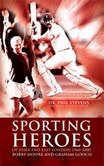Sporting Heroes
Martin Chandler |Published: 2010
Pages: 401
Author: Stevens, Phil
Publisher: Apex Publishing
Rating: 4 stars

It is not that unusual for cricket books to mention other sports, after all many cricketers, particularly in years past, have excelled in a variety of different fields of sporting endeavour and their stories necessarily contain details of their other achievements. What is rare is for a book to set out to concentrate on two different sports, but that is exactly what this, Phil Stevens’ first book, does do.
“Sporting Heroes” catches the eye both because of the references to Graham Gooch and Bobby Moore in its subtitle, and the images of them on its dust jacket. What will draw the readers in, although there is much more to the book, are the lengthy (between 70 and 80 pages) biographical pieces on each of these favourite sons of Essex.
The story of Bobby Moore is, perhaps inevitably, the more compelling of the two. Moore is, increasingly since his tragically early death in 1993, remembered for being the magnificent footballer and captain that he was. Stevens forcefully reminds us however that he was not always treated, and this criticism is aimed much more at the FA and West Ham United than the average fan, with the respect he so richly deserved and, as importantly, had surely earned.
As for Gooch he, like Moore, is the subject of a searching analysis which is well worth reading. The two stories are particularly interesting because they are not simply analyses of their subjects’ careers, or indeed biographies in the traditional sense. They are much more in the nature of an examination of personalities and character traits in an attempt to draw comparisons between the two men. This drawing of comparisons is not, in my view at least, entirely successful but that does not detract from the overall quality of these excellent accounts.
The remainder of the book, just over half of it, is devoted to a history lesson, both sporting and social. The place in English society of the East End of London and Essex, the area’s foibles and its individual features, are drawn out. After that the local history of the two sports is considered at length. There is much material on the history of Essex football, almost all of which was new to me. The past of Association Football is neither so revered nor well chronicled as that of cricket and I had no idea at all that in years gone by Essex clubs were consistently amongst the strongest amateur sides in the land nor, although I had heard mention of the place frequently (mainly in television dramas), did I know anything about Hackney Marshes.
When cricket has its turn the treatment is slightly different. There is a separate history of the Essex county club, which retreads familiar territory and breaks little new ground, although the relevant chapter is no less interesting for that. There then follows a history of the amateur game in Essex which was, I must confess, a section I thought I might just skim read, but in fact is excellent. A sad decline over many years is charted but a conclusion full of optimism for the future made for an upbeat end to a fine account.
No doubt what helps makes this book so interesting is the fact that the author has spent his life steeped in the traditions that he writes about. As to whether the book works in quite the way that it was intended to when the author set out to write it I am doubtful, as there is no great cohesion between the individual subjects that are dealt with. That said for those of us of a certain age, who have fond memories of both Gooch and Moore in their pomp, this is, particularly in this World Cup year, a book that should not be missed.






Leave a comment